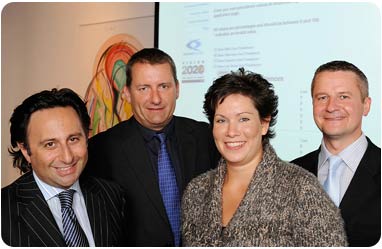Eye care aided by new online model
- 14 October 2008
 |
| Dr Steve Hajioff, PHAST, Andy Derrick, Managing Director, Motive Technology
Jo Amos, Marketing Manager, Motive Technology Dave Doherty, Motive Technology. |
A new online prevalence model for four major eye conditions promises to help UK health planners and clinicians improve patient services and anticipate changes when new treatments become available.
The National Eye Health Epidemiological Model (NEHEM) can be used to identify disparities between locally-held figures for the provision of care and evidence-based estimates of the number of people suffering from one of the four eye conditions in a particular area.
Dr Steve Hajioff of the Public Health Action Support Team (PHAST), which produced the model for the Eye Health Alliance, explained how the model worked using the example of cataracts.
“You can get a very clear indication of the likely number of people affected by that condition in the area. It’s very interesting to compare that with how many [surgical] procedures are being done, how many prescriptions are being written and how many community optometrists are working in the area.”
He told E-Health Insider that, in the future, he hoped this information could be linked to activity data from sources such as the Secondary Uses Service.
This would enable health service planners to pinpoint areas where, for example, there were high numbers of elderly people but relatively low numbers of cataract operations. This could indicate unmet need for local cataract treatment.
“The other thing is looking at cost data. We can model the impact of the cost of new treatments locally. Planners tend to assume that if you treated 100 cases last year, there will be the same again next year. A new treatment may mean that there’s more,” he said.
More subtly, the introduction of new preventive treatments means it is more important to know the prevalence of a condition so that services can adapt to reach people in the early stages of a disease. These patients are generally not on the radar if they cannot be helped by current approaches to managing a condition, which are probably focused on later stages of a disease.
Coincidentally, the National Institute for Health and Clinical Excellence approved a new treatment for one of the eye conditions covered by the model, age-related macular degeneration, three weeks ago. Other conditions covered are cataract, glaucoma and low vision.
Dr Hajioff said: “This is the first time we have had this sort of data and models at local level for eye care.”
He also told EHI he believed that much more needed to be done in what he termed “tabloid epidemiology” – communicating complex concepts in clear, simple terms. Technical partners, Motive Technology, were praised for their production of the web-based NEHEM.
“Motive were set a challenging brief to design a completely bespoke solution to meet our criteria. Nevertheless, Motive has met our every expectation and has delivered on time and on budget a model that is easy to use and easy to understand despite the large volumes of data involved.”
Information specialists who want to analyse data within the model more closely can download the figures into Excel spreadsheets work on them separately. The model also allows experts to look at the formulae used. “We think that’s the most intellectually robust part of the model. Experts around the world can look at it and help us to refine the model,” said Dr Hajioff.
Dave Doherty of Motive Technology said the main challenge for the firm, as non-specialists in healthcare, had been understanding the requirement and working with the huge amounts of data in the model.
However, the project worked well and Dr Hajioff said: “The partnership has been a huge success, to the extent that we are looking to continue working with Motive to include three more conditions.”
Links
The National Eye Health Epidemiological Model (NEHEM)




